Christie Craig's article: Teacher's Pet
![]()
Christie Craig's article: Teacher's Pet
Teacher's Pets:
Pets in the Classroom
By Christie Craig
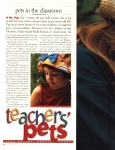
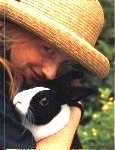
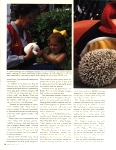

If Mr. Pig, the three-week-old pot belly
swine, has to be bottle fed every thirty minutes, how many times will
Mr. Pig eat in seven hours?
For some children this may be just a word problem. However, for the
children at the Houston based, Redd school it's so much more. Because
these students may be one of the lucky fourteen who'll feed the
orphaned pig his bottle today.
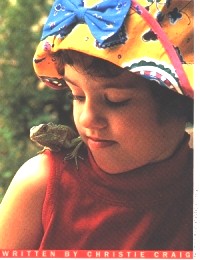 "I couldn't believe it," says one parent. "I'd gone to drop off my
son's lunch and there Mrs. LeBlanc was teaching math, chalk in one
hand, a baby pig cradled in the other. She even used the pig in her
lessons. And as crazy as it sounds, I think that pig played a part in
my son's ability to do math."
"I couldn't believe it," says one parent. "I'd gone to drop off my
son's lunch and there Mrs. LeBlanc was teaching math, chalk in one
hand, a baby pig cradled in the other. She even used the pig in her
lessons. And as crazy as it sounds, I think that pig played a part in
my son's ability to do math."
Although Mr. Pig may be one of the more unusual animals to occupy the
classrooms at the Redd School, in all reality, he's only one of many.
Because on any given day you'll find bunnies hopping around the
children's feet as they do their class work. You might find a cat
nestled on a child's lap as he reads aloud, a cockatoo intently
watching a child write his letters, a hedgehog participating in science
class, an iguana perched on the window sill, head tilted in alertness,
setting a good example in listening.
Denna Baskin, the Redd School's owner and director, is a firm believer
that animals, in all varieties, are good for a child's education. "I
grew up on a ranch," says Baskin as she strokes Cookie, her pet
cockatoo, behind her wing. "I'm sure even back in 1978 when I started
incorporating the pets into the school there were studies to back up my
beliefs, but I didn't know about the studies. As an animal lover, I had
personally experienced the benefits."
In addition to the forty or more classroom pets, the three-and-half
acre campus at the Redd School is occupied by horses, pigs, goats,
chickens, and geese. "All of them are an important part of the school's
staff," states Baskin. "Kids love animals and when you can take
something that inspires a child and use it as a teaching tool you have
a real advantage."
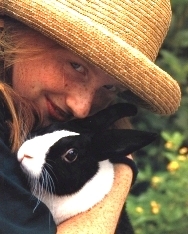 Baskin adds, "Animals are great teachers in themselves. They teach us
patience, respect for life, and responsibility. Any educator can tell
you that teaching moral issues makes algebra look like a walk in the
park."
Baskin adds, "Animals are great teachers in themselves. They teach us
patience, respect for life, and responsibility. Any educator can tell
you that teaching moral issues makes algebra look like a walk in the
park."
There is also a lot of responsibility that comes along with having
animals. Liability insurance is high and there's the issue of hygiene.
Baskin states, "Animals are unpredictable and rules have to be
enforced. However, in the last nineteen years we've had no serious
incidents but we've definitely seen the benefits."
Because of those benefits many schools are incorporating classroom pets
into their kindergarten and first grade programs. What makes the Redd
School stand out, besides the types of pets, is that their classes,
preschool through eighth grade, are all involved with the animals.
"Animals aren't age prejudice," says Baskin. "I've seen many unhappy
teenagers find comfort in a little pet time."
The relationship between children and animals can be so therapeutic
that programs exist nationwide specifically to bring troubled children
together with animals. These programs are known to work on issues,
common in adolescence, such as low self-esteem and behavioral problems.
 "As we've seen at the Redd School, those benefits aren't limited to
just the emotionally and physically handicapped," states Mary
Wakefield, Ed. D., staff Psychologist. "Most children at one time or
another will suffer from a negative self-image and some sort of
behavioral problem."
"As we've seen at the Redd School, those benefits aren't limited to
just the emotionally and physically handicapped," states Mary
Wakefield, Ed. D., staff Psychologist. "Most children at one time or
another will suffer from a negative self-image and some sort of
behavioral problem."
What does that have to do with a child's education? "Everything,"
answers Mrs. Charlotte Money, who's been teaching Kindergarten for
twenty years. "A positive self-image and a well-adjusted attitude is
crucial in learning. Although it's hard to admit being outdone by
Matilda, the class hedgehog, or Oreo, the rabbit, oftentimes my class
pets get better results at dealing with one of these problems than I."
Mrs. Money recalls one instance when a student was experiencing a
difficult home life. "I kept seeing the problems at home affect his
behavior at school. In lieu of punishment, he was given more
responsibility with the animals. Five minutes spent feeding the fish or
bottle feeding a baby lamb and he was calmer and able to return to his
class work."
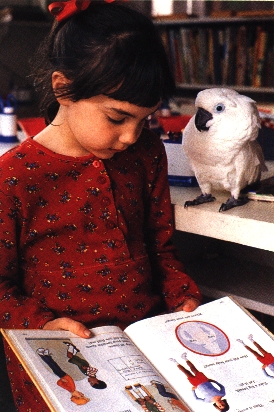 Mrs. Higham spends her days with sixteen first graders and Sam, a
floppy-eared rabbit. "He's just one of the class," says Mrs. Higham.
"He follows most of the rules and he's potty trained. There is one rule
that unfortunately," she smiles and whispers, "I mean fortunately, Sam
doesn't obey. And that's time-out.
Mrs. Higham spends her days with sixteen first graders and Sam, a
floppy-eared rabbit. "He's just one of the class," says Mrs. Higham.
"He follows most of the rules and he's potty trained. There is one rule
that unfortunately," she smiles and whispers, "I mean fortunately, Sam
doesn't obey. And that's time-out.
"Sam just doesn't understand that time-out means time alone. It sounds
ridiculous, but I believe Sam knows when a child is troubled. I'll put
a student in a corner and Sam will hop over for a visit. In few minutes
I'll see the child gently petting Sam and shortly after that we have a
more manageable attitude. I give most of the credit to time-with-Sam,
not time-out.
"Basically, I believe having an animal in the classroom is equivalent
to receiving a hug. They (animals and hugs) are good for our souls."
Common sense tells us what's good for our souls has to be good for our
minds. Science, however, has long since proven that petting and
stroking an animal can significantly lower one's blood pressure. One
study done by Brooklyn College Researcher Dr. Erika Friedmann showed
that simply having a dog in the room has a calming effect on children.
"Where petting is concerned, however, there's an added benefit for a
child. Children crave the tactile and sensory stimulation," states Dr.
Wakefield. Stroking something soft, like fur, feeds an emotional need.
This doesn't explain the children's strong bond to the hedgehog, but
some things, animal/human affection, are meant to be enjoyed not
explained.
 Another positive effect brought on by having pets in the classroom is
in the student/teacher relationship. Students have a tendency to view
educators as hard, unapproachable disciplinarians. Yet when a child
sees a teacher offering affection to a class pet they begin to see this
person in a less intimidating light.
Another positive effect brought on by having pets in the classroom is
in the student/teacher relationship. Students have a tendency to view
educators as hard, unapproachable disciplinarians. Yet when a child
sees a teacher offering affection to a class pet they begin to see this
person in a less intimidating light.
All the teachers at the Redd School agree that the animals help them do
their jobs. "Animals provoke a student's curiosity and challenge their
imaginations," states Ellen LeBlanc, teacher and surrogate mother to
Mr. Pig. "So if a student tells me `the goat ate my homework,' I have
to give him the benefit of the doubt. All joking aside, we find ways to
channel the animal-inspired enthusiasm and creativity into their
science, math, and English."
The school taps into that enthusiasm and uses it in different subjects
in various ways. Studying animals is a science in itself. At the Redd
School most the students have experienced the miracle of birth. Even
the kindergartners can tell you why some eggs contain baby birds and
some don't.
In math class, besides using Mr. Pig, the teachers encourage students
to figure fractions by giving them the responsibility of mixing formula
and feed for the animals. And a high percentage of their English papers
are written about class pets.
When you combine the imagination, and knack for adventure that animals
and children have in abundance, the opportunities for growth and
insight are amazing. "Animals can guide children willingly and
enthusiastically to new heights of maturity and wisdom," states
LeBlanc. "And if these same animals ever learn to teach math and
English, the teachers, better be on the lookout for a new career."
Quotes from students:
- "When I'm on a horse I feel as if I can go anywhere, do anything."
- "I talk to the animals," says one child. "I tell them everything because I know they'll keep a secret."
- "When I first started school I was scared. Then I met Sam, the rabbit, and he made me feel better."
- "Going to school is like going to the zoo. It's fun!"
- "Sometimes an animal will do something funny and the whole class will start laughing. I like this because sometimes school just seems too serious."
- "I love studying about the animals. They make learning fun."
